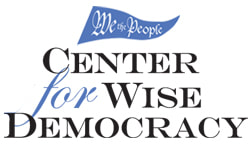In January 2019 Santa Cruz County had its inaugural Wisdom Council on the topic of the Santa Cruz branch line / rail corridor. The highly contentious nature of the rail corridor issue is what motivated us to bring this participatory model to the County in the first place.
Note that the Wisdom Council weekend was convened just days before Regional Transportation Commission [RTC] moved to vote. This was a non profit initiative with no government support or affiliation.

- January 2019 Wisdom Council by random selection Presents
- Wrap-up
- Press Release for January 2019 Wisdom Council (archival)
- “AIMS of the Wisdom Council Process” (Jim Rough)
A summary of the Wisdom Council findings was submitted to Santa Cruz County Regional Transportation Commission [RTC] on January 16, 2019, within the Public Comment period and thereby entered into the public record.
Re Santa Cruz County inaugural randomly selected ‘Citizens Council’ [aka Wisdom Council] convened on the rail corridor 1/11/2019 to 1/12/2019
“Aims of the SCC WCP” are included below the Wisdom Council ‘unity statement’ & below the Wisdom Council archival press release for this event

Santa Cruz County inaugural Wisdom Council unity statement re the iconic Santa Cruz County coastal corridor:
Railbank* the corridor, thereby opening it up to the public without delay, as a multi-modal transit corridor to serve diverse community needs, by the most expeditious means possible;
NOTE: This envisioned outcome leaves the train tracks in place for uncontested commercially viable Watsonville freight, and for Roaring Camp Railroad, Felton to Boardwalk
Further: “That we as a Community should celebrate the 2012 visionary forward-thinking, now historic choice to purchase the coastal corridor and imagine for it now, not a train on tracks but a transit combination scenario that has been heretofore as inconceivable as Jack O’Neill’s wetsuit once was. That is what Santa Cruz does. That is what has put Santa Cruz on the map, again and again. That innovative streak is inexorably a Santa Cruz hallmark/phenomenon, a Santa Cruz Cultural meme, a strength we should continue to build upon as a Community.”
*RAILBANK: established in 1983 as an amendment to Section 8(d) of the National Trails System Act, a voluntary agreement between a railroad company and a trail agency, to retain a rail corridor for possible future railroad use, opening it up as a designated public thoroughfare.

Santa Cruz County Wisdom Council
came to their
Unity Statement:
The big breakthrough was when the group said, we’ve been talking/arguing about this for 10 years, but it has only been within the auspices of the county transportation commission [RTC]. This subject is actually bigger;
It’s about “how we, as a community, get to define ourselves going forward.”;
How do we want to be thought of as a community and how does this opportunity fit into future plans for our county?
e.g. the invention of the surfboard grew out of this innovative, dynamic place.
This is really about starting the conversation that has been missing,
We are better off with ALL the community thinking about this issue – in terms of our future.
What and who we are can be reflected in every aspect of our landscape and our strategic plans.
We have no idea because the future of transportation technology is just getting started / it’s IN development
Who we are requires a bigger conversation – with ALL of the county.
*~*~*
And a key part of the transcription of the Wisdom Council participants [that Nels Olson captured as our invited scribe/observer] Sat. after lunch:
A: last night a lot of us were pro-rail; now we’re recommending “don’t-build.”
In the beginning I was excited about a rail+trail on the corridor, but when we looked at all the aspects, my mind shifted, it looks like a poor fit, for that
location, for the community. – not a lot of people, expensive, etc.
Jim: the conclusion, ultimately, is what?
S: I think it’s important to say “rail banking” since that allows the rail
guys to save face, but in the mean time, go forward with the trail ASAP, and keep the right of way for a train in the future if there’s a better kind of
train invented, or whatever.

Over and over Wisdom Councils result in the participants saying that WC’s are desired and appropriate.
Ongoing Wisdom Councils in our community is a way to find out who we all are, what we want and creative ways to move forward.
Differences in views are an ASSET, NOT a liability. Our differences help us solve the REAL problem(s)
– ‘Winning the game’ would be generating a recognizably legitimate Voice of the People. This could inspire people by making it clear that their concerns are respected and their ideas are valuable, and it could free policy makers from the sense that anything they try to do will be opposed by special interest groups and inspire them to make active use of the WCP to guide their actions. In the long run, it could lead to a systemic change in the way we organize self-governance.

RE PUBLIC FORUM AT CRUZIO DURING WHICH THIS WISDOM COUNCIL DEBRIEFED (speaking to the model)
This is the forum in which the Wisdom Council gets a platform, to share with gathered community members, their unity statement and, critically, their story of how they got there; the shifts and added dimensions that happened as they were dynamically facilitated through eleven hours total (Friday eve/Saturday all day). The Council told the story of their experience, what had occurred to them and for them as a body in the Wisdom Council context. This story is conveyed vocally and with some supporting graphics that speak to input/output and process and, inherently, to shifts and breakthroughs in thinking.
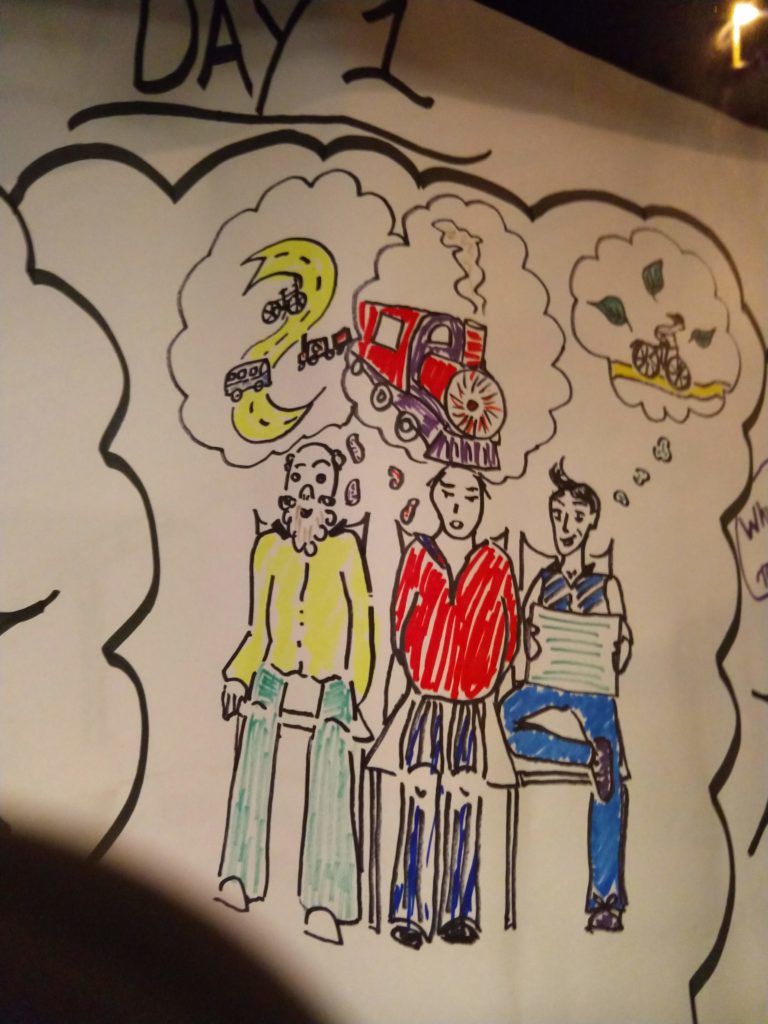
The 3 experts come in and share their perspective/position….. 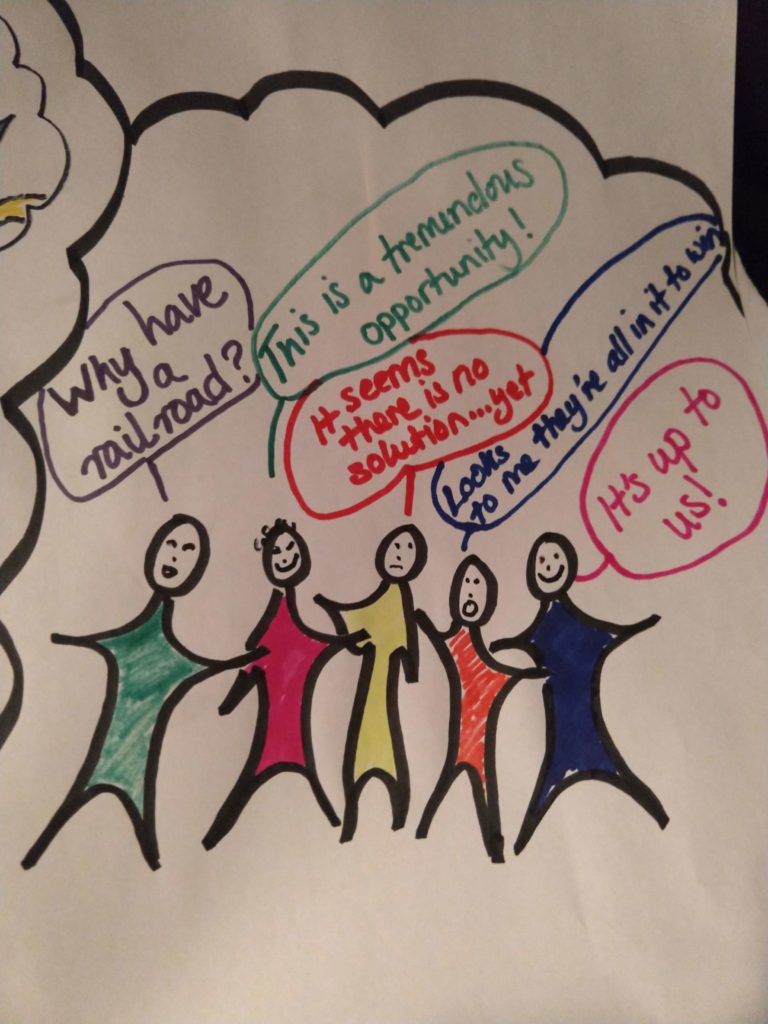
Exponential explosion of everything.. 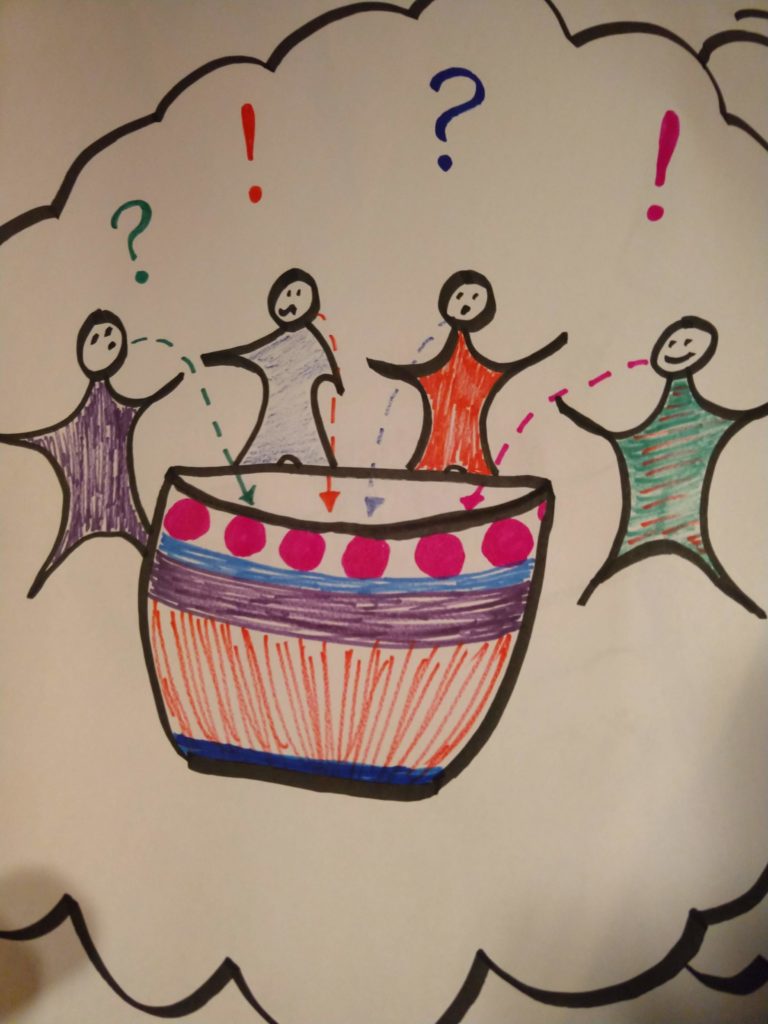
What,.. what.. what.. Wow! 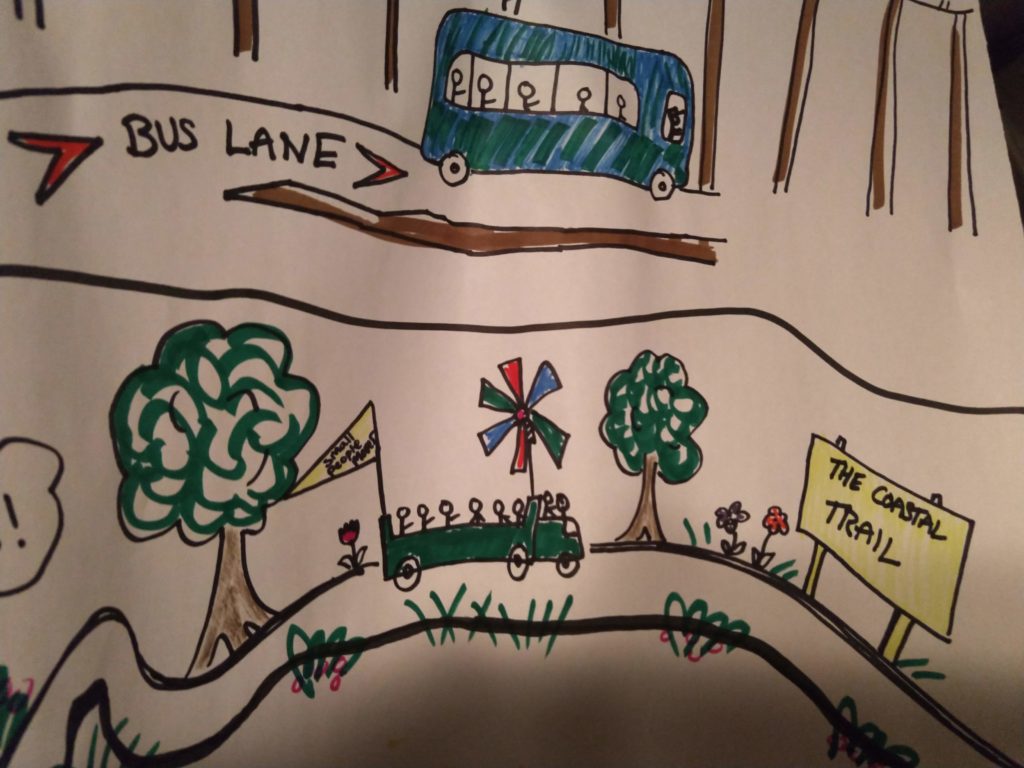
This Council delivery is followed by some format that allows those present to turn and have their own experience of sharing how they resonated with what the Wisdom Council shared. There is most often a strong resonance in those gathered for what the Council arrived at, as well as “Yes! And….” (that is to say; the new creative input generated by the Council is met most often with alignment and more creative energy and insight).
This part of the Wisdom Council Process can be set up as World Cafe, or Open Fishbowl (for instance); some format that gives everybody in the room the opportunity to speak and be heard or at least hear their thoughts reflected in another speaking. For Santa Cruz at Cruzio we did a World Cafe-type rotating triads. Thus we quickly discovered that the room was thickly populated by design with train proponents (representative of a fixed position), each of whom played that role into each triad they entered. Since we were less than one week away from the RTC deciding vote on the rail corridor stakes were high and representatives were out in force.
Center for a Wise Democracy founder Jim Rough commentary:
For this particular Wisdom Council [happening immediately prior to Regional Transportation Commission vote] we were in a high stakes moment politically; in the evening presentation there seemed to be two distinct audiences;
1) Ordinary people (excited and enthused by the presentation) and
2) Representatives (attached to set positions challenging the “conclusions”.)
I think the ordinary people were excited by the presentation and the result.
I heard more than one (ordinary) person say, “Now I get what’s happening. This is good.” . But the “representatives” couldn’t let go of the fight;
Jim Rough speaking with Mark Mesiti-Miller, in the forum at Cruzio Saturday night, commented that whenever you have a “fight”, as the County does over the coastal corridor, you know there is some legitimate voice of the People, a significant portion of the population, that is not being heard or taken into account.

When we run the model in connection with local government on big issues which are proving challenging to local government vis-à-vis the citizenry, it offers a win-win; the governed and those in office have the opportunity to face the problem shoulder to shoulder instead of in silos.

Since this Wisdom Council had a specific —rail trail— topic (not every Wisdom Council has a named topic), three divergent perspectives were invited to present. These were community members deeply steeped in the issue, which three gave their presentation in the same time period, briefly addressing the council (15 minutes each which included council members asking clarifying questions);
- Rick Longinotti – Campaign for Sustainable Transport
- Bruce Sawhill – Friends of the Rail Trail [FORT]
- Manu Koenig – Greenway
Note that a briefing such as this from Community members who are notoriously well versed in the issue is an optional step in the Wisdom Council Process [WCP]. It is something they have found useful in the Austrian legislature model of WCP. Jim Rough would emphasize that it is not the purpose of the Wisdom Council Process to make experts of the random citizens, rather that the Process itself, acting on the combined engaged citizenry, elicits an innate wisdom.
The well-established Wisdom Council/citizen’s council model in the Austrian state of Vorarlberg, came about because their ‘Office of Future-related Issues’ was proactively seeking participatory democracy models worldwide and found USA WA-based Center for Wise Democracy / Jim Rough, Dynamic Facilitation [DF] and WCP (in which randomly selected Citizens serve as a “We the People” Wisdom Council and are Dynamically Facilitated). Many years after Vorarlberg’s legislature instituted the Wisdom Council Process, Manfred Hellrigl remains unequivocal about its value for our world, from regional to geopolitical;
“I’m more convinced than ever that Dynamic Facilitation and the Wisdom Council provide the breakthrough of urgently needed tools to facilitate emergence in our society. “
—Dr Manfred Hellrigl, Director, Office of the Future Related Issues, Vorarlberg, Austria
Vorarlberg to date has more than ten years of twice-yearly ‘Civic Council’ feeding into the legislature. ‘Civic Council’ is the Austrian translation of the English ‘Wisdom Council’.

Dynamic Facilitation invites a new conversation by welcoming all input from those in the room as legitimate potentially fruitful grist for the mill. Every utterance without exception fits one of four categories; ‘Data’, ‘Concern’, ‘Solution’, Problem-statement’...; round and round, hour after hour. And the conversation morphs, marked by surprising junctures, shifts and breakthroughs.
From this arises organically, the obvious ‘Of Courses’ (what anyone can see) and ‘Actionable steps’
This makes it a very useful model not just for ‘We the People’ to get more and more educated on the issues, but as a tool for supporting elected officials. That is to say, elected officers can and do task a randomly selected group of citizens/ council to take up a particularly contentious issue in the public arena. Direct quotes from European politicians include, I couldn’t have said in public office what they came up with but I am informed by it/can act on it.
It is proven through repeated practice that a randomly selected citizens council, no matter how diverse, will arrive at a solid shared perspective which resonates with broad swathes of people in the wider community.
The citizens council will be again and again a time-capsule constellation, acting as a microcosm of the community. The [DF] facilitator tracks and rides the energy in the room, which is generated as one perspective offered activates or ignites another; builds and flashes, swerves and dives, swells and soars. And all the time the facilitator is giving 100% attention to all of it, actively receiving and noting without judgement or censure. Everything recorded in script into the four categories / onto the flipcharts for each other and all to take in.
This is a citizen council, formed and disbanded in a night and a day, its distilled perspective by no means an absolute. Breakthroughs in thinking are par for the course in this model and arise as a way out of and a way forward, beyond where anybody has been or seen.
The Jack O’Neill wetsuit reference arose from one Council member remembering that when he had lived for a time away from Santa Cruz (on the East Coast) , he found himself musing on this cool thing about Santa Cruz; “What is it about Santa Cruz..?” It struck him then that Santa Cruz has this distinct innovative streak as a built-in and abiding trait, that Jack O’Neill is a prime example of this ability to ‘see’ what might be possible beyond where people have hitherto been able to envision. Jack was ridiculed back in the day for his ‘crazy’ wetsuit idea (“human rubber suit”) but the vision proved sound, actually spectacular. Apply that maverick thinking to the coastal corridor; what 21st century transit could look like if we as a Community committed to tapping that quintessential highly innovative Santa Cruz spirit. That’s our Santa Cruz legacy and blueprint for present time future-framing.

We, in the United States, are living an unprecedented experiment in democracy, still in aspects an aspiring democracy. ‘We the People’, it transpires, is an evolving phenomenon, growing in self-awareness in this fecund cultural milieu.
Much of what has happened over time in Europe in this field was inspired by Jim Rough and his original thesis [pub. 2002]; Society’s Breakthrough; Releasing Essential Wisdom and Virtue in All of the People, in which he proposed the Wisdom Council Process as a Constitutional Amendment. In the interim years, experience in the field, especially in Europe, has pointed repeatedly to the stark imperative; Just Do It!

It’s Our Home, local Santa Cruz 501(c)3, is in for the long haul, committed to establishing Dynamic Facilitation [DF] model for innovative civic discourse in Santa Cruz County. What happened on one January weekend in Santa Cruz County was an initiatory step in a proven model for creative and profound public engagement in civic affairs, a “We the People” evolutionary step. The Wisdom Council Process is applicable local to global; right here right now, baby steps.., with a vision as bold as the Founding Fathers and Mothers.
The earth belongs in usufruct to the living.
—Thomas Jefferson
WISE DEMOCRACY SANTA CRUZ COUNTY
| PRESS RELEASE (archival) January 7, 2019 |
‘WISE DEMOCRACY SANTA CRUZ COUNTY TO FACILITATE 24 HR CIVIC COUNCIL ON THE FUTURE OF THE RAIL CORRIDOR’
Santa Cruz, CA, January 7th, 2019. This weekend a randomly selected group of citizens will convene to develop a “We the People” set of recommendations for the Santa Cruz Branch Line Rail Corridor. The event will take place just days before the Regional Transportation Commission (RTC) votes on a plan that includes freight and passenger rail. The Jan 17th vote will influence public transportation infrastructure for decades to come. Members of the public are invited to the Community Conversation on Saturday, January 12th, 6:30 PM at Cruzio Works in Downtown Santa Cruz.
The civic council will be composed of voters randomly selected from the Santa Cruz County Voter Roles. They will meet with the help of professional facilitator Jim Rough from the Center for Wise Democracy over a 24hr period, from 6:30 PM on Friday Jan. 11th to 6:30 PM on Saturday Jan. 12th. The facilitator will engage the intellect, experience and emotions of all participants in “choice creating” until the group reaches consensus on a set of recommendations. They will present these recommendations at a public Community Conversation on Saturday night for further improvement. “This is a 100% open and transparent process,” said event organizer Corrina McFarlane, “we want as many people as possible to participate.”
The event is a response to the RTC’s own public comment process which many say fall short of the “open, transparent public process” mandated by Measure D. “Many members of the tech community have spoken at RTC meetings and we basically just feel ignored,” said Doug Erickson, who leads Santa Cruz New Tech Meetup. “There’s never been an opportunity like this for citizens to actually talk to each other and work out a solution,” says McFarlane, “so far it’s just been us talking at the commissioners.”
The Center for Wise Democracy has successfully conducted this “We the People” process in Ashland – OR, Victoria – BC and Voralberg – Austria. “So far the best use case is in Austria where the local government used it to develop a response to the flood of Syrian refugees the country has seen,” said facilitator and Center for Wise Democracy Founder Jim Rough. “The people liked the process so much that they incorporated into the local constitution.” A civic council is now convened twice a year in Voralberg on varying topics.
The [Santa Cruz County] event is supported entirely by local donations. Cruzio Internet is donating their coworking space for the group to meet and both Staff of Life and Trader Joe’s are donating food to keep participants fed. Non-profit It’s Our Home is acting as the fiscal sponsor for individual donations.
Using community dialogue to overcome intractable local issues has local precedent as well. Notably, the City of Santa Cruz’s Water Supply Advisory Committee (WSAC) tackled the contentious issue of building a desal plant. Recently, Santa Cruz City Council Member Sandy Brown called for a community dialogue on the hotly contested issue of rent control.
“I’m grateful that this event is taking place,” said Rick Longinotti, WSAC participant and Board Member for the Campaign for Sustainable Transportation. “The Water Supply Advisory Committee facilitated a breakthrough,” Longinotti said, “I’ve been saying we need the same approach to transportation for months.” The process this weekend will be 24 hrs instead of 10 months long like the WSAC. It will also involve randomly selected citizens instead of participants appointed by City Council. “It’s a bit different but I’m excited to see what conclusions we can come to,” said Longinotti, “a dialogue is long overdue.”
Wise Democracy Santa Cruz County is a non-profit partnership initiative whose mission is to solve our community’s most pressing problems with a dynamic, democratic process that leverages the wisdom of all citizens.

“Aims of Santa Cruz County inaugural WCP”
included in Public Comment submitted to SCCRTC 1/17/2019
[compiled by Center for Wise Democracy Jim Rough to help us hone our SCC WCP experience]
We have big expectations from the first Santa Cruz County Wisdom Council. Here’s a list of some of them;
1) We make new headway in resolving the rail corridor issue….
a) The Wisdom Council reaches a unified conclusion;
b) The live audience resonates to this conclusion;
c) People in the community audience recognize that this is a voice of the public interest.
d) official decision-makers reorient their thinking in response to this new public voice.
2) We spark a new high-quality public conversation … about this and other important issues. The new conversation is higher quality, involves more people and is more involving of them.
3) We grow the change-agent TEAM. We want this small group of DF’ers to:
a) understand more about Dynamic Facilitation;
b) feel more confident about their own DF skills;
c) understand more about the Wisdom Council Process [WCP];
d) feel more empowered and connected to one another as a force for change.
4) We educate the public …
a) on the issue …
b) on this new “We the People” potential for change …
c) on the nature and importance of choice-creating vs. the usual debate/discussion/deliberation/polarization/voting/decision-making process.
5) We model the new self-governance process …
a) for other communities so they can try it. …
b) as a stepping stone to a national Wisdom Council Project;
c) as a model for a global WC Project
6) We demonstrate that this really works … so activists, investigative reporters, and change agents will orient toward “facilitating whole-system change” rather than the more usual: “fighting for what’s right.”
7) We improve the Wisdom Council Process … This is one more experiment where we understand more about how to put on a Wisdom Council (or Creative Insight Council) and find better ways to select random people, to run the community cafe, to convene a ‘responder’ meeting, etc.
8) We awaken new energy for democracy … This sparks a growing awareness of a hopeful new solution strategy to society’s biggest problems … and new story of progress on the “heroic journey.”°
And the Press Release that preceded this January Wisdom Council Process (see above)
Nels Olson, scribe and observer of our SCruz Wisdom Council by invitation, commented that an analogy could be a baseball game, identifying whether a Wisdom Council hit a homerun… or not.
Jom Rough repies:
The points of assessment you bring (1st base, 2nd base, etc.) are important and should be added in some way to the list of aims, probably to Aim #1. You say “hitting a home run”, for instance, would be to determine … “a breakthrough idea that bypasses entrenched disagreements and makes nearly everyone who was formerly arguing about A vs. B realize ‘of course, we should just do C!’” Gosh, yes … that does happen sometime, like in the examples you mention. And I think it may be happening in this WC too.
With every Wisdom Council it is critical to help the WC focus on the SHIFTS they make. This helps them to couch their conclusions and their story in terms of these shifts. I think this Wisdom Council experienced a shift, for instance, in realizing:
The vision for this project should be determined by the people in conversation, not so much by the representatives, experts and stakeholders of the RTC in a fight. This is a community-defining project for Santa Cruz and its future. “We” need to get past the fighting and start coming up with what “we” want. And do it in a way that builds the spirit of community.
I think this is an out-of-the-box breakthrough realization that is just getting started … maybe something “everyone” can get behind.
If the Wisdom Council presented everything in terms of a story about their shifts, then the combatants can listen. Then they can notice the big picture … this is what happens when you get a group of random people together to look at this issue. And the “ordinary” people are resonating. And to begin to feel the spirit of the new conversation … beyond the fight … that might take over.
I saw “home runs” like this … the beginning of the new conversation. I’m especially excited about the progress of the ” change-agent team”/It’s Our Home [Wise Democracy in Santa Cruz County]. They are planning to continue supporting and sparking this new version of democracy through the Wisdom Council Process. And we learned so much from the experiment about working with a conflicted issue, assembling random people these days, linking with official governmental bodies, working with expert input, etc. It is a story we can track going forward to help others imagine a different future. Heck, we did this with no money, little official support, little media support, just 5 or so random people, stepping into high conflict, etc. Amazing. Oh! And a collection of turned-on genius-level activists!
One other thing to say; I think the Wisdom Council and the audience we gather … and the community too … all need to develop process awareness.
To recognize that this is the missing conversation for how democracy is supposed to work. .
–Jim Rough
I believe in democracy because it releases the energy of every human being.
Woodrow Wilson, US President, 1913-1921
